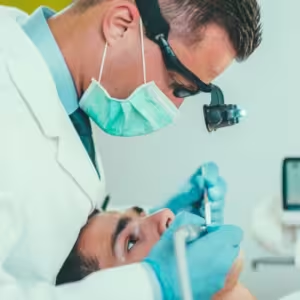Root canal therapy is a dental procedure that is often misunderstood but plays a crucial role in saving teeth that are severely infected or decayed. At Dental 32 in Ashburn, VA, Dr. Ninh and his team are committed to providing comprehensive dental care, including root canal treatment when necessary. Let’s delve into what the root canal procedure entails, why it’s performed, and what patients can expect during and after the treatment process.
What is a Root Canal?
A root canal is a treatment used to repair and save a tooth that is badly decayed or infected. During the procedure, the nerve and pulp (soft tissue inside the tooth) that have become infected are removed, and the inside of the tooth is cleaned and sealed. Without treatment, the tissue surrounding the tooth can become infected, leading to abscesses, bone loss, and potentially severe pain.
Signs and Symptoms That May Require a Root Canal
Several signs and symptoms indicate that a root canal may be necessary:
-
Severe Tooth Pain: Constant or severe pain in the tooth, especially when chewing or applying pressure.
-
Prolonged Sensitivity: Sensitivity to hot or cold temperatures that persists after the hot or cold stimulus is removed.
-
Discoloration of the Tooth: Darkening of the tooth compared to surrounding teeth.
-
Swelling and Tenderness: Swelling and tenderness in the nearby gums, indicating possible infection.
If you experience any of these symptoms, it’s crucial to schedule an appointment with Dr. Ninh promptly for an evaluation.
Steps Involved in a Root Canal Procedure
**1. Initial Consultation and Examination:
The process begins with an initial consultation and examination by Dr. Ninh. He will review your dental history, perform a thorough examination of the affected tooth, and may take X-rays to assess the extent of the infection.
**2. Anesthesia:
Before the root canal procedure begins, local anesthesia is administered to numb the tooth and surrounding area. This ensures that you remain comfortable throughout the procedure.
**3. Accessing the Tooth:
To access the infected pulp, Dr. Ninh creates a small opening in the crown of the tooth. This step allows him to remove the infected or damaged pulp tissue from the pulp chamber and root canals.
**4. Cleaning and Shaping the Canals:
Using small, specialized instruments, Dr. Ninh carefully cleans and shapes the root canals to remove any remaining pulp debris, bacteria, and infected tissue. This step is crucial for preventing further infection and ensuring the canals are ready for sealing.
**5. Filling the Canals:
Once the canals are cleaned and shaped, they are filled with a biocompatible material called gutta-percha. This material seals the canals to prevent bacteria from re-entering and causing future infections. In some cases, a temporary filling may be placed to protect the tooth between appointments.
**6. Restoring the Tooth:
After the root canal is completed, Dr. Ninh will discuss options for restoring the tooth’s functionality and appearance. Depending on the extent of the damage, a dental crown may be recommended to strengthen and protect the tooth. The crown is custom-made to match the shape and color of your natural teeth, restoring both function and aesthetics.
Post-Treatment Care and Recovery
After a root canal procedure, it’s normal to experience some mild discomfort or sensitivity, which can usually be managed with over-the-counter pain relievers. Dr. Ninh may prescribe antibiotics if there was an active infection.
1. Maintain Oral Hygiene:
Continue to brush and floss regularly to keep the treated tooth and surrounding gums clean and healthy.
2. Attend Follow-Up Appointments:
Attend any follow-up appointments scheduled by Dr. Ninh to ensure the tooth is healing properly and to monitor the success of the treatment.
3. Avoid Chewing on Hard Foods:
To protect the restored tooth and prevent any damage, avoid chewing on hard or sticky foods until the permanent restoration (such as a crown) is placed.
Benefits of Root Canal Treatment
-
Saves Natural Tooth: Root canal therapy allows you to retain your natural tooth, which is typically the best option for oral health and function.
-
Relieves Pain: By removing infected or damaged tissue, root canal treatment alleviates severe tooth pain and discomfort.
-
Prevents Spread of Infection: Treating the infection prevents it from spreading to other teeth or surrounding tissues, minimizing the risk of more serious complications.
-
Restores Functionality: Following root canal treatment and restoration with a crown, the tooth can function normally for biting and chewing.
Conclusion
Understanding the root canal procedure is essential for alleviating fears and misconceptions surrounding this common dental treatment. At Dental 32 in Ashburn, VA, Dr. Ninh and his experienced team are dedicated to providing compassionate care and effective root canal therapy to preserve your natural teeth and restore oral health. If you suspect you may need a root canal or have questions about the procedure, don’t hesitate to contact us for a consultation. We are here to help you achieve a healthy, pain-free smile through advanced dental care and personalized treatment plans. Trust Dental 32 with your dental health needs and discover the benefits of modern root canal therapy today.
FAQ
Are non-covered benefits unnecessary?
Non-covered benefits may not be deemed medically necessary by insurance providers but can still be essential for maintaining dental health.
What should I do if a procedure isn’t covered by insurance?
If a procedure isn’t covered by insurance, it’s essential to discuss alternative payment options with your dentist and budget for the expense accordingly.
Can I skip regular dental check-ups if they’re not covered by insurance?
Regular dental check-ups are critical for preventive care, regardless of insurance coverage. Skipping them can lead to more significant dental issues in the future
Why is it important to budget for dental expenses?
Budgeting for dental expenses ensures that you can cover the costs of non-covered benefits and access necessary treatments when needed.

